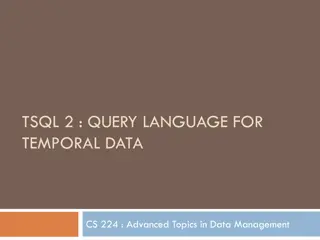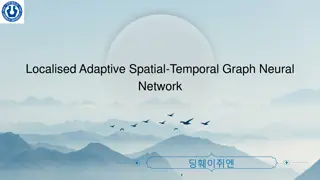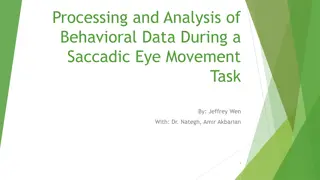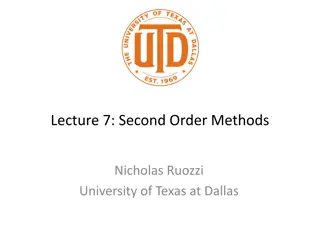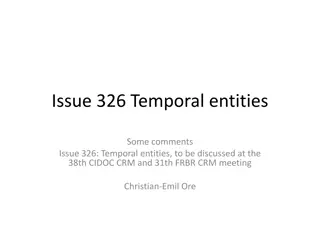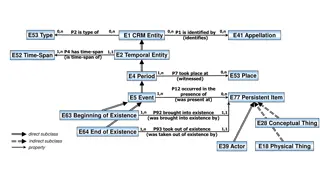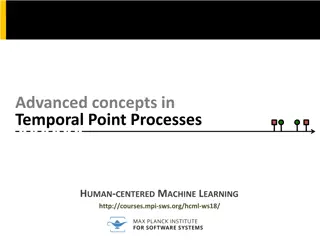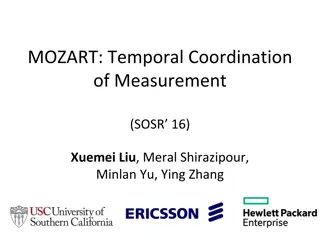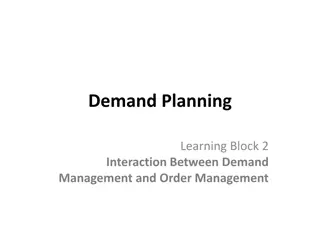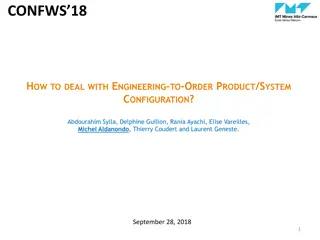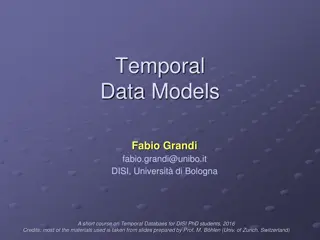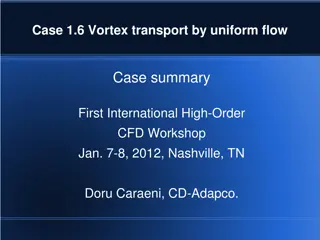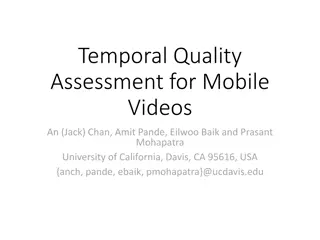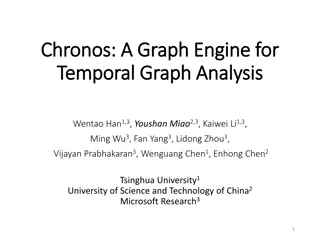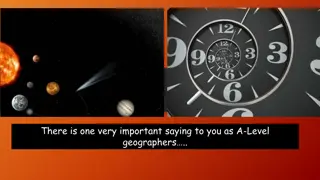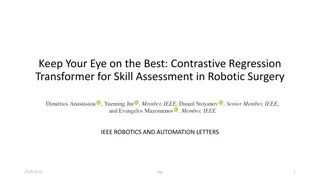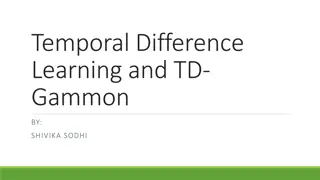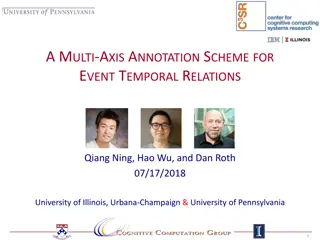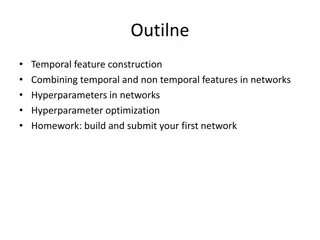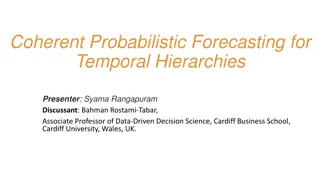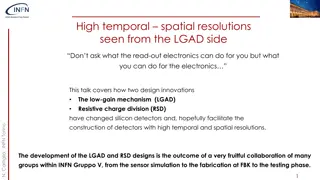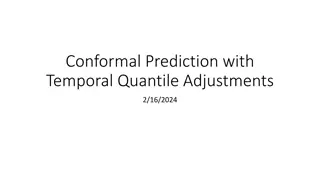Semi-Supervised Credit Card Fraud Detection via Attribute-Driven Graph Representation
Explore a novel approach for detecting credit card fraud using a semi-supervised attribute-driven graph representation. The technique leverages temporal aggregation and attention layers to automatically unify heterogeneous categorical attributes and detect fraudulent transactions without label leaka
7 views • 23 slides
Deep Reinforcement Learning for Mobile App Prediction
This research focuses on a system, known as ATPP, based on deep marked temporal point processes, designed for predicting mobile app usage patterns. By leveraging deep reinforcement learning frameworks and context-aware modules, the system aims to predict the next app a user will open, along with its
4 views • 24 slides
Temporal Data Management in TSQL Queries
Explore the realm of temporal data in TSQL queries, delving into the concepts of valid time and transaction time, different types of relations like snapshot and bi-temporal, and the significance of time dimensions in database management. Learn how temporal databases support time-related queries for
7 views • 41 slides
Localised Adaptive Spatial-Temporal Graph Neural Network
This paper introduces the Localised Adaptive Spatial-Temporal Graph Neural Network model, focusing on the importance of spatial-temporal data modeling in graph structures. The challenges of balancing spatial and temporal dependencies for accurate inference are addressed, along with the use of distri
6 views • 19 slides
Behavioral Data Analysis During Saccadic Eye Movement Task
Visual systems utilize saccades to focus on objects, impacting temporal perception. This study explores the effects of saccades and stimulus location on perceived time, presenting findings from an experiment on temporal perception mapping with fixed visual duration. The method of psychometric functi
3 views • 12 slides
Optimization Methods: Understanding Gradient Descent and Second Order Techniques
This content delves into the concepts of gradient descent and second-order methods in optimization. Gradient descent is a first-order method utilizing the first-order Taylor expansion, while second-order methods consider the first three terms of the multivariate Taylor series. Second-order methods l
2 views • 44 slides
Discussion on Temporal Entities and Simultaneity in CIDOC CRM Meeting
Temporal entities and the modeling of simultaneity in CIDOC CRM are under discussion at the upcoming meeting. The current approach considers the cardinality of certain relations, aiming to streamline the representation of time-spans and spacetime volumes. The evolving perspectives on the spatial com
5 views • 5 slides
Temporal and Spatial Information Models
This content delves into the intricacies of temporal and spatial information models, covering concepts such as existence, presence, and spatiotemporal relationships. It explores how entities are identified, events are witnessed, and durations are defined within these models. The interplay between ti
6 views • 9 slides
Advanced Concepts in Temporal Point Processes for Human-Centered Machine Learning
Explore advanced concepts in temporal point processes through the lens of human-centered machine learning. Topics include marked temporal point processes, independent identically distributed marks, dependent marks, and mutually exciting marks. Learn about stochastic dynamical systems such as the Sus
5 views • 8 slides
Temporal Coordination of Measurement in Data Centers
Measurement plays a crucial role in data centers for fault diagnosis, traffic engineering, and attack detection. This study focuses on the concept of temporal coordination of measurement to overcome issues like reporting overhead and resource wastage. Various examples illustrate the importance of co
2 views • 29 slides
Demand Planning and Order Management: Enhancing Efficiency
Explore the intricate relationship between demand planning and order management, crucial for optimizing customer order fulfillment cycles. Learn key principles, tools, and techniques to enhance communication and manage demand effectively, along with contemporary approaches and e-commerce fulfillment
6 views • 28 slides
Engineering-To-Order Product/System Configuration Strategies
Strategies for dealing with engineering-to-order product/system configuration including assemble-to-order, make-to-order, configure-to-order, and engineer-to-order approaches. Highlights different levels of diversity, challenges, and solutions in personalized system configurations.
1 views • 10 slides
Overview of Temporal Data Models and Time Dimensions in Databases
Explore the concepts of temporal data models and time dimensions in databases, covering topics such as data structures, query languages, different timestamp types, valid time, and transaction time. Learn about the importance of supporting various time aspects in database systems and the complexities
1 views • 52 slides
Vortex Transport by Uniform Flow - High-Order CFD Workshop Summary
Vortex transport by uniform flow case study presented at the First International High-Order CFD Workshop in 2012. It focuses on assessing the efficiency of high-order methods for LES/DES of turbulent flows and comparing them with state-of-the-art 2nd order FV algorithms. The case involves a very low
2 views • 11 slides
Temporal Quality Assessment for Mobile Videos
This research focuses on developing a novel Temporal Variation Metric (TVM) to assess the temporal quality of mobile videos. The approach aims to accurately measure temporal information without the need for optical flow methods, making it suitable for embedded devices. The methodology, including the
4 views • 20 slides
Probabilistic Database Model
This research explores the development of a temporal-probabilistic database model to handle uncertain temporal facts obtained from information extraction methods. Motivated by the need for scalable query engines and a lack of unified approaches supporting both time and probability aspects, the study
3 views • 21 slides
Temporal Graph Analysis for Real-world Graph Evolution
Chronos: A Graph Engine for Temporal Graph Analysis in a social graph environment from years 2012 to 2014. Uncover insights through temporal graph properties and user ranking variations across different years. Discover the evolution of real-world graphs and the computation of properties on graph sna
2 views • 43 slides
Digital Twin Navigator: Temporal Scales and Strategy
A Digital Twin offers a wide spectrum of possibilities, with varying temporal scales and strategic implications. Learn how different temporal scales influence decision-making and see a practical example of a digital twin strategy for a new hospital building. Discover the sophistication levels and ke
4 views • 11 slides
Time-Aware User Embeddings as a Service
Providing time-aware user/activity embeddings as a service to different teams within a company offers a centralized and task-independent solution. The approach involves learning universal, compact, and time-aware user embeddings that preserve temporal dependencies, catering to various applications s
5 views • 15 slides
Extracting Dense Regions from Hurricane Trajectory Data
This research paper discusses the extraction of dense regions from hurricane trajectory data using spatio-temporal analysis techniques. The study explores the application of DBSCAN algorithm and temporal extension for clustering hurricane data based on spatial and non-spatial attributes. Experimenta
2 views • 21 slides
Mastering Spatial and Temporal Evaluation in A-Level Geography
Enhance your spatial and temporal evaluation skills as an A-Level geographer by delving into the importance of evaluating space and time, particularly within the context of the Australia Wildfires 2019. Understand spatial analysis, impact significance, and temporal evaluation scales to deepen your c
2 views • 13 slides
Contrastive Regression Transformer for Skill Assessment in Robotic Surgery
Explore the innovative Contrastive Regression Transformer model, Contra-Sformer, tailored for skill assessment in robotic surgery. This model focuses on expressing the similarity levels between surgical executions, enabling precise evaluation based on spatio-temporal deviations from a reference. Lev
1 views • 24 slides
Formal Systems and Temporal Logic for System Design
Explore the fundamentals of temporal operators, logic, and transition systems in formal system design, with a focus on the importance of temporal logic and its application in implementing logical specifications. Dive into the world of assertion IPs, temporal properties, and Kripke structures for a d
0 views • 88 slides
Temporal Difference Learning and TD-Gammon: Advancements in Reinforcement Learning
Explore TD-Gammon, a neural network that learns backgammon by self-play, uncovering novel approaches in reinforcement learning. Understand the benefits of reinforcement learning, challenges like temporal credit assignment, and advancements in nonlinear function approximation methods like Temporal Di
1 views • 27 slides
Temporal Relations Annotation Scheme for Event Understanding
Explore a multi-axis annotation scheme for event temporal relations, addressing challenges of low inter-annotator agreement and time-consuming processes. The approach redefines the task to enhance accuracy and efficiency in temporal relation extraction.
0 views • 23 slides
Joint Reasoning for Temporal and Causal Relations
Explore the importance of understanding temporal and causal relations in events, leveraging examples to illustrate how temporal and causal determinations are interconnected. Discover how time-sensitive information aids in establishing relationships between events, enhancing comprehension through joi
1 views • 22 slides
High-Resolution Temporal Spatial Applications with LGAD
Delve into the innovative design concepts like LGAD and RSD transforming silicon detectors for enhanced temporal and spatial resolutions. Explore the advancements made by INFN Torino in silicon sensor technology for improved tracking capabilities, utilizing LGAD-based detectors and FAST ASICs. Uncov
4 views • 37 slides
Optimizing Network Performance with Hyperparameters and Temporal Features
Explore the intricate world of hyperparameter optimization, combining temporal and non-temporal features in network construction. Dive into learning rates, optimizers, network architecture, activation functions, and more for building your first efficient network. Get ready to train a network and sub
1 views • 5 slides
Higher Order Derivatives in Mathematics
Explore the concept of higher order derivatives in mathematics by delving into finding second, third, or higher order derivatives of functions. Learn how to interpret second order derivatives in the context of velocity and acceleration functions. Discover the notation and efficiency of expressing hi
3 views • 12 slides
Bayesian Analysis of Spatio-Temporal Dynamic Panel Models
Explore the Bayesian analysis of spatio-temporal dynamic panel models with fixed and random effects. Learn about the spatial and temporal correlation in data and the estimation of covariance functions. See how these models are applied to analyze economic factors affecting crime data in Tehran city.
0 views • 32 slides
Coherent Probabilistic Forecasting for Temporal Hierarchies Presentation by Syama Rangapuram
Explore the framework for coherent probabilistic forecasting in temporal hierarchies presented by Syama Rangapuram. Discover how this end-to-end approach enhances forecasts across various temporal granularities, guaranteeing non-negativity and reducing model variance.
1 views • 8 slides
Anatomy of Temporal Bone: Dr. Rahul Bagla's Insights
Explore the intricate details of human temporal bone anatomy as explained by Dr. Rahul Bagla, a renowned authority in the field. Learn about the structure, relations, and parts of the temporal bone, including the squamous part and its crucial connections to surrounding bones. Enhance your knowledge
5 views • 22 slides
Temporal Databases and Their Applications
Explore the significance of temporal databases, their applications in various sectors like healthcare and finance, and the limitations of traditional databases in managing temporal data effectively. Learn how developers can overcome these challenges to enhance data organization efficiently.
3 views • 69 slides
Innovations in LGAD and RSD Designs for High-Temporal Spatial Resolutions
Explore how the LGAD and Resistive Charge Division (RSD) designs have revolutionized silicon detectors, enhancing temporal and spatial resolutions. Discover the collaborative efforts behind these innovations and the implications for sensor and ASIC systems. Uncover the secrets to achieving good temp
1 views • 39 slides
Formal Systems for Temporal Logic in Computer Science
This course covers the basic temporal operators and why they are essential in transitioning from combinational to sequential behavior in logics. Explore linear time, branching time logic, SystemVerilog assertions, and architectural styles for assertion IPs. Understand the significance of temporal lo
4 views • 88 slides
Temporal Quantile Adjustment for Conformal Prediction in Healthcare
Explore the application of temporal quantile adjustments in conformal prediction for estimating patient outcomes using physiological time-series data. Learn how to improve longitudinal coverage in predictive modeling across a population of patients by adapting to temporal dependencies.
1 views • 15 slides
Inter-temporal Production Decision in Economics
In economics, both consumers and producers face decisions on resource allocation for current and future production. This involves analyzing production possibilities curves, budget lines, and optimizing consumption bundles with inter-temporal preferences, influenced by interest rates. Through visual
1 views • 7 slides
Temporal Difference Learning and TD-Gammon
This content delves into the intriguing concepts of temporal difference learning and its application in TD-Gammon. The text provides an in-depth exploration of these topics, shedding light on their significance in the realm of artificial intelligence and gaming strategies. Readers will gain valuable
0 views • 27 slides
Customize Sales Order Attributes: Enhance Order Management Efficiency
Discover how to customize sales order attributes in Frontier 4.1 for a more efficient order management process. This includes flexible alternatives to database free fields, customizing views, integrating with PCM Configurator, and establishing attribute relationships. Learn about validation details,
2 views • 29 slides
Understanding Temporal Databases and Their Importance
Explore the world of temporal databases, from their motivation to comparisons with conventional databases, and delve into temporal data models, query languages, and indexing methods. Learn about transaction time databases, bi-temporal databases, and examples like sales data management.
3 views • 42 slides


